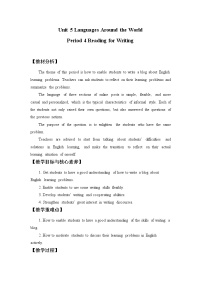

高中英语人教版 (2019)必修 第一册Unit 5 Languages around the world教学设计
展开
这是一份高中英语人教版 (2019)必修 第一册Unit 5 Languages around the world教学设计,共4页。
Unit 5: Languages Around the World Aims and Objectives:By the end of this lesson, students should be able to:Understand the concept of language families and their distribution around the world.Analyze the similarities and differences among languages from different families.Use descriptive language to express personal opinions and cultural awareness.Develop reading comprehension skills through an authentic text. Materials Needed:Whiteboard and markersPictures of languages and language familiesAuthentic reading passage on languages around the world Procedure: Step 1: Warm-up The teacher can display pictures of different languages and ask students to identify them. The teacher can then ask students to share any interesting facts they know about these languages. Step 2: Pre-reading The teacher can introduce the topic of the reading passage and ask students to predict what the passage will be about. The teacher can also ask students to brainstorm different language families and their distribution around the world. Step 3: Reading The teacher can distribute the reading passage and ask students to read it silently first, and then read it out loud as a class. The teacher can pause after each paragraph and ask students to summarize what they have understood. The teacher can also explain any difficult vocabulary or concepts as necessary. Step 4: Comprehension questions The teacher can ask students to answer comprehension questions based on the reading passage. These questions can be both factual and inferential. The teacher can also ask students to provide evidence from the text to support their answers. Step 5: Vocabulary and grammar exercises The teacher can provide vocabulary and grammar exercises related to the reading passage to reinforce language skills. For example, the teacher can ask students to identify and explain the meaning of specific words or phrases, or to use certain grammar structures correctly in sentences. Step 6: Group discussion The teacher can divide students into small groups and ask them to discuss the similarities and differences among languages from different families. The groups can then present their ideas to the class, and the teacher can facilitate a class discussion. Step 7: Writing activity The teacher can ask students to write a short essay or paragraph about their favorite language and why they find it interesting. The essay can include a description of the language's unique features, cultural context, and personal connection. Step 8: Reflection The teacher can ask students to reflect on what they have learned about languages around the world and their cultural significance. The teacher can also ask students to think about how they can apply this knowledge to their own language learning and cultural awareness. Conclusion: By the end of this lesson, students should have a better understanding of language families and their distribution around the world. They should also be able to analyze and compare different languages based on their unique features and cultural context. Additionally, this lesson can help students develop their reading comprehension skills, vocabulary and grammar skills, critical thinking skills, and cultural awareness. Exercises: Fill in the blanks with the correct word or phrase from the reading passage:a. A ___________ is a group of languages that have evolved from a common ancestor.b. ___________ is the most widely spoken language family in the world.c. ___________ is a language family spoken in Southeast Asia and the Pacific Islands.d. The ___________ family includes languages spoken in India, Pakistan, and Bangladesh. Match the language family with its description:a. Indo-Europeanb. Sino-Tibetanc. Austronesiand. Afro-Asiatic i. Spoken in sub-Saharan Africa and the Middle Eastii. Spoken in China, Tibet, and Myanmariii. Spoken in Southeast Asia and the Pacific Islandsiv. Spoken in Europe, South Asia, and North America Rewrite the following sentences using the passive voice:a. People all over the world speak English.b. Mandarin Chinese has more native speakers than any other language.c. French is spoken in many countries around the world.d. Spanish is widely used as a second language in the United States. Answers: a. Language familyb. Indo-Europeanc. Austronesiand. Indo-Aryan a. Indo-European - ivb. Sino-Tibetan - iic. Austronesian - iiid. Afro-Asiatic - i a. English is spoken by people all over the world.b. More native speakers than any other language speak Mandarin Chinese.c. Many countries around the world use French as a language.d. Spanish is widely used as a second language in the United States. Homework: Research a language family not covered in the reading passage and write a short report on its distribution, unique features, and cultural significance. Your report should include information on where the language family is spoken, how many people speak it, and any notable subfamilies or dialects within it. You should also explain any cultural or historical factors that have influenced the development and spread of the language family. Finally, reflect on what you have learned about the diversity of languages around the world and how it has affected your understanding of language learning and cultural awareness.










